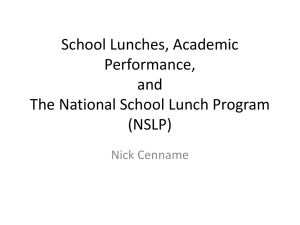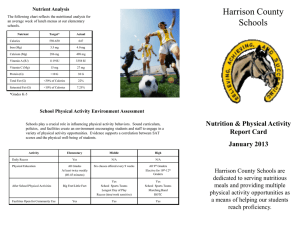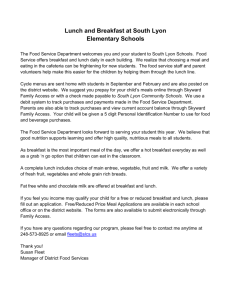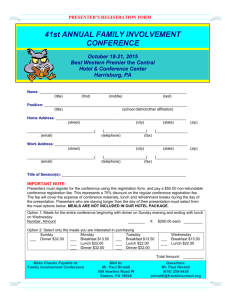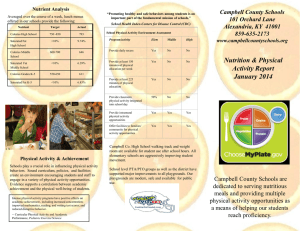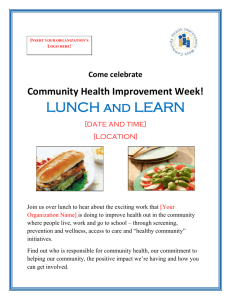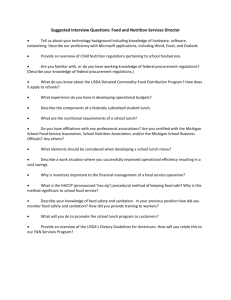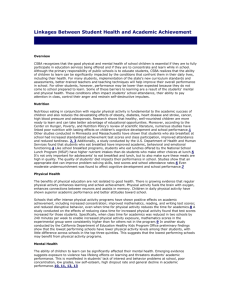Harlan County Schools Nutrition & Physical Activity Report Card for
advertisement
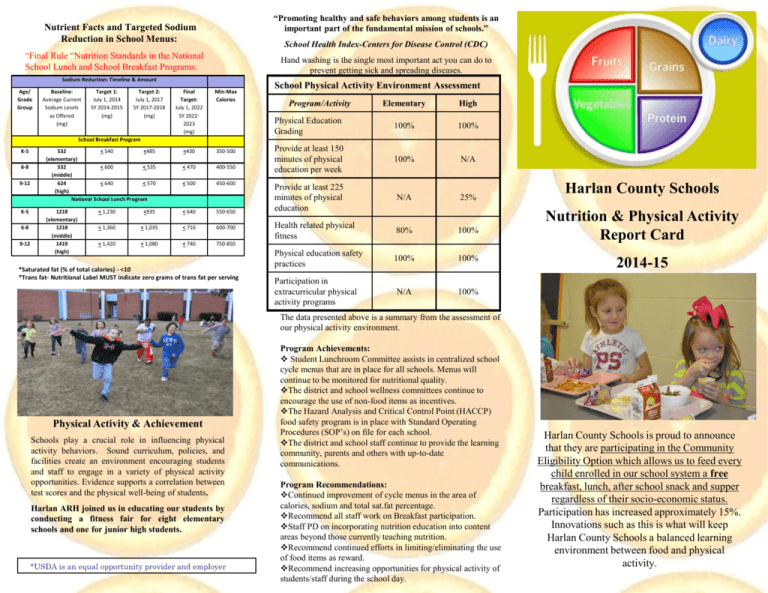
“Promoting healthy and safe behaviors among students is an important part of the fundamental mission of schools.” Nutrient Facts and Targeted Sodium Reduction in School Menus: School Health Index-Centers for Disease Control (CDC) “Final Rule “Nutrition Standards in the National School Lunch and School Breakfast Programs: Hand washing is the single most important act you can do to prevent getting sick and spreading diseases. Sodium Reduction: Timeline & Amount Age/ Grade Group Baseline: Average Current Sodium Levels as Offered (mg) Target 1: July 1, 2014 SY 2014-2015 (mg) Target 2: July 1, 2017 SY 2017-2018 (mg) Final Target: July 1, 2022 SY 20222023 (mg) Min-Max Calories <430 350-500 < 470 400-550 < 500 450-600 School Physical Activity Environment Assessment Program/Activity Elementary High Physical Education Grading 100% 100% Provide at least 150 minutes of physical education per week 100% N/A Provide at least 225 minutes of physical education N/A 25% Health related physical fitness 80% 100% Physical education safety practices 100% 100% N/A 100% School Breakfast Program K-5 6-8 9-12 K-5 6-8 9-12 532 < 540 <485 (elementary) 532 < 600 < 535 (middle) 624 < 640 < 570 (high) National School Lunch Program 1218 (elementary) 1218 (middle) 1419 (high) < 1,230 <935 < 640 550-650 < 1,360 < 1,035 < 710 600-700 < 1,420 < 1,080 < 740 750-850 *Saturated fat (% of total calories) - <10 *Trans fat- Nutritional Label MUST indicate zero grams of trans fat per serving Participation in extracurricular physical activity programs Harlan County Schools Nutrition & Physical Activity Report Card 2014-15 The data presented above is a summary from the assessment of our physical activity environment. Physical Activity & Achievement Schools play a crucial role in influencing physical activity behaviors. Sound curriculum, policies, and facilities create an environment encouraging students and staff to engage in a variety of physical activity opportunities. Evidence supports a correlation between test scores and the physical well-being of students. Harlan ARH joined us in educating our students by conducting a fitness fair for eight elementary schools and one for junior high students. *USDA is an equal opportunity provider and employer Program Achievements: Student Lunchroom Committee assists in centralized school cycle menus that are in place for all schools. Menus will continue to be monitored for nutritional quality. The district and school wellness committees continue to encourage the use of non-food items as incentives. The Hazard Analysis and Critical Control Point (HACCP) food safety program is in place with Standard Operating Procedures (SOP’s) on file for each school. The district and school staff continue to provide the learning community, parents and others with up-to-date communications. Program Recommendations: Continued improvement of cycle menus in the area of calories, sodium and total sat.fat percentage. Recommend all staff work on Breakfast participation. Staff PD on incorporating nutrition education into content areas beyond those currently teaching nutrition. Recommend continued efforts in limiting/eliminating the use of food items as reward. Recommend increasing opportunities for physical activity of students/staff during the school day. Harlan County Schools is proud to announce that they are participating in the Community Eligibility Option which allows us to feed every child enrolled in our school system a free breakfast, lunch, after school snack and supper regardless of their socio-economic status. Participation has increased approximately 15%. Innovations such as this is what will keep Harlan County Schools a balanced learning environment between food and physical activity. National School Lunch The National School Lunch Program (NSLP) was conceived in 1946 as a “measure of national security to safeguard the health and well-being of the Nation’s children.” School districts receive federal reimbursement for each school lunch served that meets the United States Department of Agriculture nutrition guidelines. These guidelines promote meal quality. Our lunch meals are planned on a four-week menu cycle and are planned to provide 1/3 of the recommended dietary allowances for school-age children. Federal regulations require that we offer minimum portion sizes of meat/meat alternate, fruit, vegetable, grains and fluid milk during every lunch meal service. Weekly regulations: fruit 2 1/2 cups, vegetables 3 3/4 cups, meat/meat alternate 9-10oz, grains (whole grains) 8oz minimum, milk 5 cups. The portion sizes are designed to meet the needs of growing children. Menus are also planned to include a variety of choices and changes have been made in food specifications and preparation to lower sodium, fat and calories in school meals. Schools operate on the offer vs. serve method. This means that the student gets to choose what he or she eats. Out of the 5 required menu items they may refuse 1or 2 items offered, but must take a minimum of 3 items to qualify as a reimbursable meal. We offer entrée’s, fruit choices, vegetable choices, and whole grain choices. The menu cycle provides for variety and allows us to make the most efficient use of the donated commodities, especially seasonal fresh fruits. We offer 1% lowfat unflavored milk, skim/fat-free flavored and unflavored milk, as well as 100% fruit and vegetable juices. After-School Program The After-School Snack and Supper Program allows after-school care programs with regularly scheduled activities in an organized, structured environment to provide and claim reimbursement for snacks and supper served to school-age children. School Breakfast The School Breakfast Program (SBP) was established in 1966. School districts receive federal reimbursement for each school breakfast served that meets the U.S. Department of Agriculture’s nutrition guidelines. It has been proven that children who are hungry find it hard to stay alert and participate in their classroom experience. Studies show that children who participate in the School Breakfast Program have significantly higher standardized achievement test scores than non-participants. Children with access to school breakfast also had significantly reduced absence and tardiness rates. Breakfast is offered in all county schools free. “Protecting children’s health and cognitive development may be the best way to build a strong America.” -- Dr. J. Larry Brown, Tufts University School of Nutrition FRESH FRUIT AND VEGETABLE PROGRAM The Fresh Fruit and Vegetable Program (FFVP) provides all children in participating schools with a variety of free fresh fruits and vegetables throughout the school day. It is an effective and creative way of introducing fresh fruits and vegetables as healthy snack options. The FFVP also encourages schools to develop partnerships at the State and local level for support in implementing and operating the program. This program is seen as an important catalyst for change in efforts to combat childhood obesity, help form better eating habits, and introduce children to a variety of produce that they otherwise might not have had the opportunity to sample. Pricing of Breakfast and Lunch Harlan County Public Schools is part of the Community Eligibility Option which feeds all our students a free breakfast, free lunch and a free after school snack and supper. Employees of Harlan County Public Schools and visitors are required to purchase their meals. Prices are as follows: Breakfast Students FREE Lunch FREE Employees $2.25 $3.25 Visitors $2.75 $3.75 Food and beverage items that are sold as extras on the cafeteria lines meet the nutritional guideline standards of the Kentucky Board of Education for allowable foods to be sold. Nutritional Data sheets may be obtained by contacting Jack Miniard, Director, School & Community Nutrition at 606-573-4330. All principals have been given the nutritional guideline standards that are required by Kentucky Board of Education for allowable foods to be sold through school stores/vending machines. Nutritional data sheets are on file at each school and may be obtained by contacting the principal or posted on Harlan County web page. A USDA study showed students who eat school meals are more likely to consume milk, meats, grain mixtures and vegetables compared to students who did not, including students who brought meals from home. Also, students who eat school meals have higher intakes of some vitamins and minerals, including calcium and Vitamin A -- nutrients that tend to be “problem nutrients” for kids. Cost-wise, schools work very hard to make sure that school meals are a good value (free). Take a look at the number of items typically offered to students at lunch -- an entrée, two servings of fruits and vegetables, a bread or grain item and 8 ounces of milk. It takes a real balancing act to beat that value with a bag lunch.--National Dairy Council
